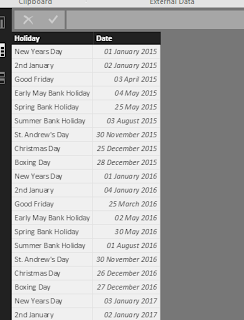PowerBI : How to Calculate number of WorkingDays between 2 given dates

Here i am going to explain how to calculate number of working dates between to given dates. In my approach i am taking a table called Holidays which contains holidays as shown below Once you have this table , we need to use this table in our Datetime table to calculate IsworkingDay column. Now give the relationship between Datetime and Holidays tables as shown below DAX : IsWorkingDay = IF (NOT(DateTime[Day of Week]= "Saturday" || (DateTime[Day of Week]= "Sunday")) && COUNTX(RELATEDTABLE(Holidays),2)<1,1,0) Now you can create calculated column or measure Total Working Days Column = SUMX ( FILTER ( 'Datetime', 'Datetime'[Date] >= Tasks[Input Start Date] && 'Datetime'[Date] <= Tasks[Input End Date] ), 'Datetime'[IsWorkingDay] ) Total Working Days Measure = SUMX ( FILTER ( 'Datetime',
